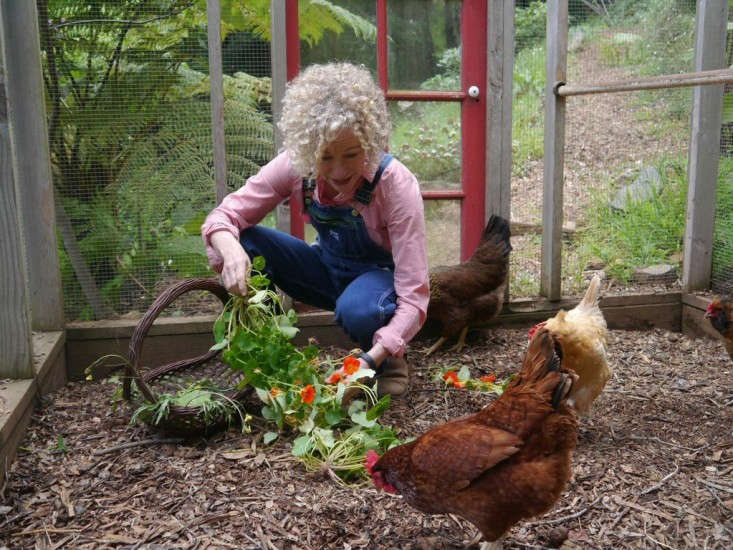When it comes to keeping chickens, there’s a lot to know! With a little research, new chicken keepers can get a handle on the basics of feeding, housing, and egg laying without too much trouble. However, there is always something new to learn about chickens. Here are seven facts that aren’t in the books, and may be quite surprising to you.
Featured photograph by Kerry Michaels, from Homeward Bound: My Childhood Connecticut, Only Better, at Dirt Road Farm.
1. Spring chicks are healthier chicks.
Chicks are commonly associated with spring in popular culture, and for good reason. Spring is the best time to purchase chicks, particularly in March or April. The key reason for hatching chicks in spring is to give them a head start on the hot summer season. During the summertime chicks are more susceptible to disease and parasites. At such a vulnerable time in their development, contracting a disease or parasite could be fatal. By starting the chicks out in spring, they will be matured into pullets by the summer and will be much more resilient to illness.
2. Chickens’ eyes can show signs of illness.

As the old saying goes, “the eyes are the window to the soul.” Well, for chickens, the eyes are the window to their physical wellbeing. Get to know what normal healthy chicken eyes looks like, and peculiarities will be easy to spot. Some examples of ailments that affect the appearance of a chicken’s eyes include Poxvirus, Avian encephalomyelitis, and Vitamin A deficiency. Ocular symptoms may include lesions on the eyelids, dryness, or even blindness in the case of avian encephalomyelitis. So, to stay on top of the flock’s health, check their eyes daily; it may seem tedious, but the benefits are worth it.
3. Chickens enjoy social connections.
Even the most skittish, asocial chickens like to engage in social activities with one another every once in a while. Social bonding is seen most when chickens are preening or dust bathing. Chickens can preen themselves by spreading oils through their feathers with their beak, and can dust bathe themselves by digging a hole and throwing the dirt all over themselves. However, even though this can be done individually, chickens prefer to engage in these activities as a group, plucking at each other’s feathers and throwing dust all over everyone. Dr. Richard Blatchford of UC Davis explains that, “chickens don’t really touch each other very often, unless it’s in a sort of negative context…. Dust-bathing though is one of those times that chickens will actually touch each other and it’s in a very positive manner.” The social nature of preening and dust-bathing maintains lasting social bonds, and even reduces stress.
4. Earlobe color is an indicator of egg color.

Different breeds of chickens will lay different color eggs. Most people are accustomed to seeing white or brown eggs, but eggs can also be green, blue, or pink! Truth be told, an egg’s color is unrelated to its nutritional value; eggs will generally have the same nutritional value regardless of what color the shell is. However, different chicken keepers may still have different preferences about what egg color they want their flock to lay. Besides breed, egg color is related to the hen’s earlobe color. On a chicken, the earlobe is located on the side of their head. Hens with white earlobes will lay white eggs. Hens with red earlobes will lay brown eggs.
5. Chickens sometimes eat eggs.
Eggs are tasty, and sometimes a hen will indulge in her own eggs. She will not stop with just one, either—once the habit starts, it is hard to stop, and she will definitely need help breaking it. The best way to prevent a chicken from eating her eggs is to stop any eggs from breaking in the nest. As long as there is sufficient bedding and the eggs are gathered frequently, there shouldn’t be any egg breakage. To stop egg eating after it’s already started, put glass eggs, artificial white eggs, or torn pieces of white paper in the nest in place of real eggs. This will frustrate her, and pecking at the decoys will give her no reward. If none of that works, she may need to be removed from the nesting area for a while.
6. Chickens can be used for therapy.

Often when people hear, “therapy animal,” they picture a dog that has received specialized emotional support training. However, chickens can be raised as therapy animals, and it doesn’t require any intensive training—touching, petting, and holding chickens is therapeutic in itself! Typically, raising backyard chickens for therapy will require specific breeds. For instance, Silkies are extremely soft and love to be held, so they would make great therapy chickens. Leghorns, on the other hand, tend to be flighty and avoid human contact altogether, so they would not be ideal. All it takes to find a therapy chicken is a little research into different breeds’ habits.
7. There are over 100 domestic chicken breeds.
When starting a backyard flock, know that there are many, many breeds to choose from. There are over 100 domestic breeds, and different types have risen and fallen in popularity over centuries of chicken keeping. Each breed has different laying capacities, lifespans, personalities, and temperaments, and there is a unique bird to match any goal that a chicken keeper has, from egg production to therapy. Just know that certain birds may be less common or less suited for beginning keepers.
Hopefully after reading these facts, it will be a whole lot easier to handle a flock of backyard chickens, and understand their behavior too!
For more on chickens, see:
- Modern Farmer: 9 Backyard Gardens with Chickens
- The Exquisite Egg: Raising Chickens with Style at the Fancy F
- Free-Range Chicken Gardens: How to Create a Beautiful, Chicken-Friendly Yard












Have a Question or Comment About This Post?
Join the conversation (0)